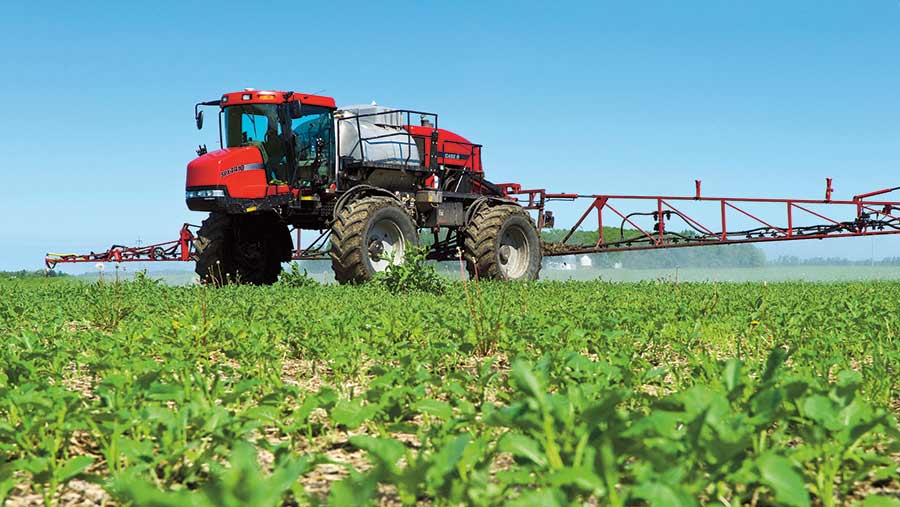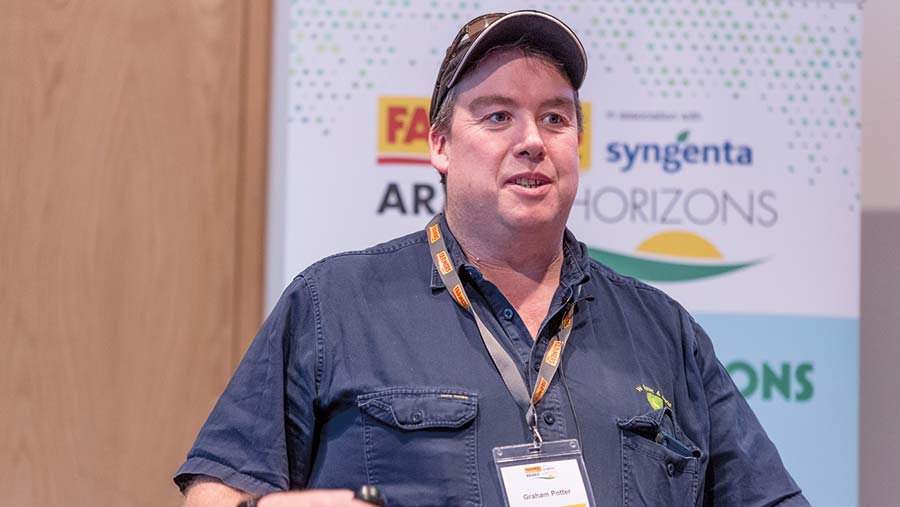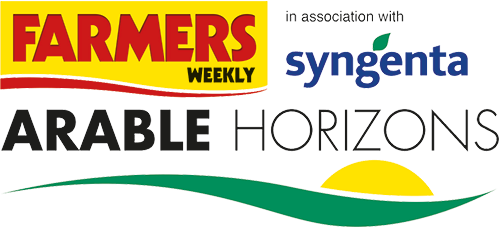5 ways new tech can improve pesticide applications
 © Dave Reede/Design Pics Inc/Alamy Stock Photo
© Dave Reede/Design Pics Inc/Alamy Stock Photo With pressure on plant protection products from regulators and the growing problem of resistant weeds, pests and diseases, it is increasingly important to use them as accurately and effectively as possible. Farmers Weekly takes a look at the technology that can help.
1. Pulse width modulation improves accuracy
Pulse width modulation (PWM) has failed to take off in the UK so far, but that may be about to change as growers strive for more accuracy and flexibility in their spray applications.
Conventional sprayers have a rate controller which senses when the machine speeds up or slows down and adjusts spray pressure to increase or decrease the flow rate through the nozzles to maintain a target dose.
The weakness of the system is that fixed-orifice nozzles are sensitive to pressure, and at slow forward speeds a drop in pressure can cause the spray pattern to deteriorate and result in poor coverage.
Conversely, going faster increases pressure, resulting in finer droplets that are prone to drift, resulting in poor efficacy and potentially causing off-target environmental issues.
See also: How a farmer cut fungicide with variable-rate applications
This means operators have to stick to a steady speed, but this isn’t always possible with big kit on undulating ground, or where there is a big difference between target forward speed and the requirement to slow down for headland turns or around obstacles and then accelerate away, according to Canadian spray expert Tom Wolf.
He explains that in North America large, high-clearance sprayers driven at speeds up to 30kph amplify the issues of drift and poor coverage when operating at a pressure outside a particular nozzle’s comfort zone.
This results in inefficient use of pesticides, and there is a worry that it is contributing to the rise of resistant weeds, pests and diseases, as over-dosing may select for development of high levels of single-gene resistance, while under-dosing may select for polygenic resistance.
To overcome this, some sprayer manufacturers offer PWM on their machines. It is a system where each nozzle body has its own solenoid, which can vary flow rate without adjusting pressure or sacrificing coverage or droplet size.
This is achieved by turning the flow on and off up to 10 times per second, and the pulse width – the period of time the valve is open and allowing liquid through – dictates the dose. Increasing the pulse width increases the dose and vice versa.
This approach results in more accurate and consistent application in a range of conditions and means adjusting pressure is no longer needed to dictate flow, so the operator can set a pressure that gives the best coverage and drift control results, without changing nozzle tips.
In addition, PWM has resulted in much more accurate swath control – allowing individual nozzle shut-off and turn compensation – and has opened the door to variable rate and spot spraying applications for more targeted use of plant protection products.
One argument for lack of adoption in the UK is its smaller field sizes and machines that travel at lower forward speeds, but it is more likely to be the circa £27,000 price tag to have PWM installed on a 36m machine.
However, the obvious benefits mean we are starting to see the technology creeping on to UK farms.
2. Spot spraying technology for herbicides
PWM has allowed engineers to develop systems that use sensors across the width of spray booms to detect weeds in real time and switch on individual or multiple nozzles to hit them with herbicide.
The earliest incarnations use near infrared (NIR) sensors such as WEEDit and Trimble’s WeedSeeker and have been particularly popular in large-scale grain-producing areas such as Australia, South America, the US and Canada.
The two products have allowed for the elimination of blanket spraying of stubbles in between crops, targeting only green areas with broad-spectrum weed killers such as glyphosate and saving as much as 90% in chemicals costs for some applications.
Taking spot spraying a step further is a “third generation” spot spraying system that uses optical cameras to identify specific weeds on the move.
The technology was a product of EIT Digital, a knowledge and innovation hub for the European Institute of Innovation and Technology that pulls together 130 European corporations, start-ups and research organisations.
French start-up Bilberry developed the concept and recently signed an agreement with Dutch sprayer manufacturer Agrifac to take it to market as an option on its machines.
The Bilberry system is the first commercial broad-acre application of real-time “green on green” weed recognition, so it is able to pick out weeds in a growing crop and treat them with selective herbicide, rather than the “green on brown” spraying achieved with NIR systems.
The first farmers to be offered the system commercially are in Australia, where it is able to reliably pick out problem wild radish and volunteer oilseed rape in growing cereal crops. As the system’s image library grows, more species will be added to the list.
Similar to Agrifac’s camera-based system, drones are also being used to take images of cropping land at sub-millimetre resolution and artificial intelligence identifies weed species “green on green” and produces a bespoke spray plan for each field.
An example service provider is Canadian-Israeli tech firm Green-eye Technology, which boasts yield improvements and reduction in herbicide use of up to 50%.
3. Drone spraying set to take off
The need for boom sprayers may soon be a thing of the past, as drone spraying technology continues to develop and regulators warm to the idea of the unmanned aircraft applying crop protection products.
That is the view of Jack Wrangham from DroneAG, who is working with Harper Adams University and fellow drone service provider Crop Angel to encourage a shift in legislation to allow crop spraying by drones.
There are up to 25,000 drones working in China, spraying anything from tea to rice and it is hoped that the correct regulatory environment could pave the way for a similar uptake in the UK.
The consortium is engaged with the Chemicals Regulations Directorate (CRD) and trials have already started on bracken spraying, where drones could provide a useful unmanned alternative to helicopters.
Aspects such as nozzle choice have been researched and the consortium has also carried out extensive drift tests and shown that the drone spraying devices will behave reliably in the way they should.
The drift data shows that, when working 2-2.5m off the ground, the system is comparable to boom sprayers when working above vegetation. Drift will increase as the vegetation becomes less dense, however, because of the down-draft from propellers.
At present, there is not enough data to gain a CRD approval for commercial pesticide applications, so a further year of trials is required. These will include “live” bracken spraying experiments, plus nutrient applications and assessment of spinning-disc technologies, such as the Xaircraft P20 spinning-disc applicator, which don’t require CRD approval.
The vision is for multiple drone systems carrying out mapping and targeted applications work, with larger machinery required for seeding and harvest only, dramatically reducing soil damage.
Other advantages include rapid application when spraying only small patches and a significant reduction in chemicals use.
Despite some progress on legislation, some hurdles still remain, such as the maximum drone spray tank size of 10 litres and the industry still being reliant on bulk fertilisers as a nutrient source.
4. Decision support tool to improve spray timing
Fera’s new and improved CropMonitor decision support tool will go live in 2019. It aims to significantly improve the effectiveness and accuracy of spray applications in a range of crops.
In the past, CropMonitor – which uses weather-based models to predict disease risk – has been risk-averse in its output, as it can identify ideal conditions for infection, but doesn’t account for the presence or absence of fungal spores.
However, an Innovate-UK investment, as part of the Crop Health and Protection Centre (CHAP), will see the introduction of a network of automated and relatively low-cost SporeSentry spore traps into the system.
The spore traps feed the missing spore information back into the model in real time via the mobile network and will dramatically improve the accuracy of disease predictions.
This will allow those who sign up to the subscription service to assess risk of diseases such as yellow and brown rust and septoria much more accurately and help sprayer operators target fungicide sprays for maximum effect.
5. Outdoor laboratory will bring new ag-chem to market faster
It is well documented that UK growers are losing available plant protection products rapidly and agrochemicals manufacturers are struggling to get new molecules approved to fill the gaps left behind.
However, Fera’s new E-Flows mesocosm at its site near York will help accelerate the registration process by identifying those that are safe for the aquatic environment quickly and efficiently, helping to keep crops free of pests, weeds and disease.
The largest of its kind in Europe, it consists of 60 2m x 10m “streams” that have a base volume of 4,000 litres. Different flows can be pumped through each stream, along with the addition of aquatic flora and fauna of whatever habitat is being simulated.
This allows researchers to create controlled but realistic aquatic environments, from ponds to ditches or streams, for accurate assessment of an agrochemical’s impact on natural habitats.
Progressive grower improves application accuracy at minimal cost

Graham Potter © Jim Varney
Forward-thinking Yorkshire grower Graham Potter is cost-effectively harnessing a number of precision tools to improve the accuracy of spray operations across his 200ha arable unit near Thirsk.
Running a 24m Bateman RB17, Mr Potter has made a number of additions and modifications to the self-propelled machine, including a John Deere rate controller he picked up for £800 on a working holiday to Australia.
Rather than invest heavily in individual nozzle shut-off, he increased the number of boom sections from four 6m sections to six sections at just 4m, allowing his RTK auto shut-off to reduce overlap more accurately.
In addition, when the sprayer was purchased three years ago, he also sourced a Norac UC5 boom height control system for £4,000 to keep his booms running at the best height for optimal application and drift reduction.
“[The Norac] is a long-term investment… If I have this sprayer for 10 years, I can take it off and put it on to the next sprayer,” he adds.
Taking flight
About the same time the RB17 arrived, Mr Potter added a DJI Phantom Pro drone to the kit list for just over £1,000.
This was combined with a £65/month subscription to Drone Deploy, a software platform that allows users to automate drone flights, sending the gadget over a field where it takes multiple images. The software then stitches the images together to create a detailed map.
Mr Potter has used these maps to identify problem areas and diagnose the problem on the ground. After importing a tif file into Gatekeeper, he manually creates an application map for the sprayer.
Although some may describe the system as crude, Mr Potter gives some examples of how this approach it is cutting his costs.
In one 9.86ha field he identified some manganese-deficient patches. After creating a DIY application map, instead of treating the whole area for £112.30, he treated just 2.1ha and saved himself £88.40.
Weed mapping
Similarly, he has used the system to identify and map sterile brome patches, allowing him to target the grassweed with glyphosate in the autumn and the same patches with a post-emergence treatment in the spring.
With brome treatment Unite (flupyrsulfuron-methyl + florasulam) plus adjuvant costing about £41.72/ha, in one go he slashed £842 off his spring chemicals bill by treating just 2.13ha instead of the whole 21.84ha.
“This is how I’m getting my money back [on the investment in technology],” adds Mr Potter.
This investment will continue, with Mr Potter now the owner of a Yara N Sensor, which he plans to use for variable-rate fertiliser and plant growth regulator applications, starting this spring.
What is Arable Horizons?
All experts in this article were speaking at the latest in the series of Farmers Weekly Arable Horizons events at the National Agri-food Innovation Campus, near York.
The series, in association with Syngenta, aims to explore tomorrow’s farming technology.
To find out more about Arable Horizons, and to see the content from previous events, go to the Arable Horizons website.
Sponsor’s message

Exciting developments in precision farming technology are poised to revolutionise the way all farm crop inputs are applied and used.
Driven by growers’ demands to be ever more efficient, along with legislative pressure to be better and more targeted, Syngenta New Farm Technologies are at the forefront of developing practical and proven solutions for farmers and agronomists.
Continued investment and research into smart innovations in products, varieties and support will further improve the precision and performance of future applications – with many of these new innovations set to be standard farm practice in the future.
Thanks to Syngenta for its sponsorship, which enabled us to run Arable Horizons. Farmers Weekly had complete editorial control of this report.

